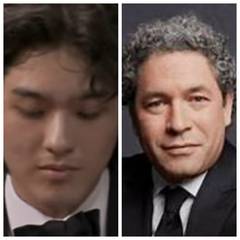|
Back
A Pair of Incredible Icons New York
Wu Tsai Theater, David Geffen Hall, Lincoln Center
09/11/2025 - & September 12, 13*, 16, 2025
Leilehua Lanzilotti: of light and stone (World Premiere)
Béla Bartók: Piano Concerto No. 3, BB 127
Charles Ives: Symphony No. 2
Yunchan Lim (Pianist)
New York Philharmonic Orchestra, Gustavo Dudamel (Conductor, Music & Artistic Director Designate)

Y. Lim/G. Dudamel (© Wikimedia Commons/New York Philharmonic)
“It may well be that some composers do not believe in God. All of them, however, believe in Bach.”
Béla Bartók
Quodlibet (Latin for “whatever you wish” from quod, “what” and libet, “pleases”) is a musical composition that combines several different melodies–usually popular tunes–in counterpoint, and often in a light‑hearted, humorous manner.”
Wikipedia
Methinks the full houses for the first three nights of the New York Philharmonic were not for Ives, Bartók or Hawaiian composer Lanzilotti. Every seat was packed to see and hear two of the most iconic young figures in serious music today.
Nor were they disappointed. As always, Gustavo Dudamel was a physical and musical dynamo. At times–like the introduction of the Bartók Concerto second movement–a dynamo of tautness, nuances of whispers. At times, like the Ives 2nd Symphony, a whirligig of insanity. More on that later.
The other icon was young Korean pianist Yunchan Lim. One fears that his reputation is so stellar, filled with the utter apogees of adjectives, that he might disappoint. That was impossible.
He bounded on stage, allowed the New York Phil to take the first three measures, and the Bartók Third Piano Concerto was all his. This was the penultimate work by Bartók. Less dissonant, more lyrical, vastly more accessible than his other piano concertos, this wasn’t for lack of energy. Rather, knowing he was at death’s door, Bartók wrote it for his wife, hoping that its less than impossible composition would allow her to perform it and bring in the shekels.
Yunchan Lin, youngest ever winner of the Van Cliburn Competition, offered a performance both intelligent and (when necessary) aggressive. But mainly he and Maestro Dudamel offered the utmost sensitivity, a caressing of the keys, a plethora of double‑octaves. Yet one rare marveled at his virtuosity. One was entranced by touch and care, and, predominantly, the attentive concern for the rapidly changing dynamics.
Bartók described the second movement as Adagio religioso. Mr. Dudamel’s orchestral introduction and “night‑music” were, if not quite religious, purely spiritual.
The Bartók came–thankfully–after of light and stone by the Philadelphia-born native Hawaiian, Leilehua Lanzilotti. In this case, one had to read the program notes, since Ms. Lanzilotti framed her 15 minutes around the complex history of Hawaii’s royalty, its forced American sovereignty, a few Hawaiian tunes, “loving encounter in the forest”, and the coming of electric lights!
Amongst other events.
I studied these four full program notes and four 1890’s photos, but it didn’t help. Mainly, after a soft brass fanfare, the composer stopped and started, with rare solos on triangle and viola, the brass repeats and the autochthonal tunes. Perhaps Ms. Lanzilotti could take these few resplendent moments and work them into a more structured musical poem.
The final work was Charles Ives’ Second Symphony, a work that once was considered unplayable, unlistenable or both. In 2025 more than a century after its composition, that seems rather silly. The Symphony is easy, fun and the perfect example of what the composer said about his own inspiration.
“In ‘thinking up’ music I usually have some kind of a brass band with wings on it in back of my mind.”
Exactly. Add to his brass band and an endless procession of American traditional band‑music (his father was a renowned brass‑band conductor) was an equally endless quodlibet of songs. Sometimes harmonic, more often dissonant, with a finale of what-the-hell-let-the-whole-damned-orchestra-blare. It all sounds pretty tame these days, but in the early 20th Century, it almost was a shocking as Sacre.
How did Gustavo Dudamel handle it? More or less, like a hungry kid in a candy store. From the Columbia, Gem of the Ocean to a finale so insanely dissonant that Sacre sounds like Mary Had a Little Lamb, the Philharmonic blasted their hearts out. And even in the sentimental second movement, Ives assuaged his Brahmsian bathos with those explosions.
In the final movement, I had the subversive thought that, had the Phil decided not to play, Gustavo Dudamel’s obligatory acrobatics for each and every quodlibet was visually as exciting as his aural electricity.
Harry Rolnick
|